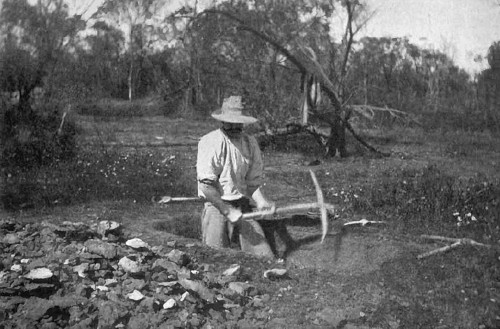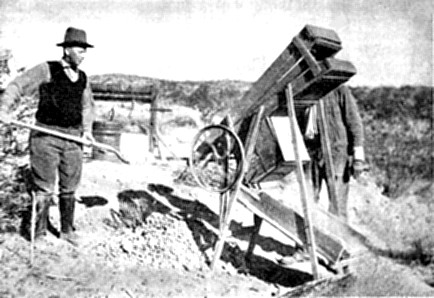Three geologic conditions are usually operative in the formation of placers: (1) The occurrence of gold in bed rock to which erosion has access; (2) the separation of gold from the bed rock by weathering or abrasion; and (3) the transportation, sorting and deposition of the weathered and eroded auriferous material. Based on the various geological processes at work, placer deposits may be formed in different ways, as follows:
Eluvial or Residual placers. These originate in those regions where gold bearing rocks are subjected to deep weathering, during which the gold may undergo more or less concentration, and also migrate down slope to some extent. The residual placers are those in which there has been no water transportation, the concentration of gold being due solely to rock weathering. The gold grains are usually angular, as they have not been exposed to the wearing action of streams. In the United States, this type is known in the southern Appalachians, and the California "seam diggings" but it has also been found in Australia, Brazil, the Guianas in South America, some places in Europe, etc.
Gold placers may be formed by rapid erosion of hard rocks, but such placers are not often rich and highly concentrated. In the great placer regions the concentration has generally been preceded by an epoch of deep secular decay of the surface. It has been supposed by many that this deep rock decay is peculiar to the tropics, but this is not correct. The process has been active in the southern Appalachian States, in California, and even in Alaska, as well as in countries like the Guianas and Madagascar. When the outcrops of gold-bearing veins are decomposed a gradual concentration of the gold follows, either directly over the primary deposits or on the gentle slopes immediately below. The vein when located on a hillside bends over (Fig. 73) and disintegration breaks up the rocks and the quartz, the latter as a rule yielding much more slowly than the rocks; the less resistant minerals weather into limonite, kaolin, and soluble salts. The volume is greatly reduced, with accompanying gold concentration. The auriferous sulphides yield native gold, hydroxide of iron, and soluble salts. Some solution and redeposition of gold doubtless take place whenever the solutions contain free chlorine. The final result is a loose, ferruginous detritus, easily washed and containing easily recovered gold. This gold consists of grains of rough and irregular form and has a fineness but slightly greater than that of the gold in the primary vein. Miner have applied to such residual concentrations, which may be worked like ordinary placers, the term eluvial gold deposits.
In the gold region of the southern Appalachian States the decomposition of the country rock, which generally is a schist, may reach a depth of 100 feet or more. The decomposed material of the auriferous veins slides downhill, mixing with the weathered rock, and during this process the gold in part sinks deeper into the detritus. This has given rise to a peculiar system of mining by which the whole mass is washed by the hydraulic method and the more resistant quartz boulders crushed in a stamp mill with coarse mesh. This has been practiced at Dahlonega and is often called the Dahlonega system. Similar deposits were worked in California, particularly in Eldorado county, and are here called "seam diggings" from the fact that the gold occurs disseminated in quartz seams traversing a certain belt of schists. Such deposits frequently occasion legal contests owing to the uncertainty whether they should be considered as placers or as mineral-bearing veins. In certain regions of Brazil the schists and gneisses are covered by auriferous detritus accumulated in place. Another example is the "Tapanhoancanga" of the same country. This is a bed of residual or lateritic iron ore up to 10 feet thick covering the underlying hematite schist and containing gold throughout. The gold probably occurs in veinlets in the schists and the gold-bearing detrital material has been concentrated from a considerable thickness of schist weathering in place.
Excellent examples of eluvial deposits are reported from Dutch, British, and French Guiana, though ordinary stream placers are the most common deposits in these countries. Over a great part of this gold-bearing territory secular decay of crystalline rocks has resulted in a deep mantle of ferruginous clayey earth laterite and in places the gold has been concentrated in this material below outcrops of gold-bearing veins. Many of the stream beds are also worked for placer gold, the detritus usually resting on the clayey surface of the compact laterite. It is stated that many rocks in the Guianas contain gold and that the placer gold is derived from such material; particularly are the basic rocks, diabases and amphibolites, said to be auriferous. This conclusion should probably be accepted with some reserve. It seems more probable that the gold contained in the greenstones is derived from mineralized fracture or stringer zones.
In French and British Guiana and Brazil, the lateritic deposits containing gold are more or less confined to the plateau and lesser hill- slopes occupied by diorites, diabases, amphibolites, epidiorites, and hornblende schists rocks which are regarded as the most frequent carriers of primary gold. It has been definitely proved in these districts that the acid gneisses, granites, and porphyries are not the source of the metal. In the valleys occurs the usual type of alluvial 'placers.' There is little doubt that much of the gold is set free by the complete oxidation of auriferous pyrite, and such an origin has been claimed for the metal in the detrital deposits of the Appalachians. The Appalachian gold-bearing region is essentially one of mica-schists, but the detrital gold deposits are dependent not so much on the schists, as on a number of basic dykes which cut them. In India these deposits are more or less restricted to the peninsula, are of Recent or sub-Recent date, and rest on metamorphic and igneous rocks. Most of the detrital gold of India has been derived from quartz veins in the metamorphic rocks, and from chlorite and hornblende schists. In Madagascar a red lateritic deposit derived from rocks traversed by auriferous quartz veins yields the metal in some quantity, and large nuggets have from time to time been discovered. The Lydenburg deposits are due to the breaking down and complete oxidation of masses of auriferous pyrites, and are connected with a variety of rocks.
Dry or Aeolian placers. In arid desert regions, where the rocks are disintegrated by long exposure on the surface, the lighter particles may be blown away while the heavier ones, including gold, remain behind. This is basically a subclass of residual placers. Certain placers in Australia have been concentrated only through the agency of the wind, the lighter material having been removed. Some placers in Arizona and Nevada fall into this class as well. Deposits concentrated by aeolian agencies can, of course, be formed only in dry countries where long sub-aerial decay has paved the way for the work of the dust storms; from the decomposed and crumbled outcrops of the lodes the winds blow away the lighter sand, leaving a mass of coarser detritus which contains the gold. Such wind-born placers have been noted by H. C. Hoover and T. A. Rickard near the croppings of the West Australian gold veins. Examples of this kind from the Cordilleran States of America, include some of the deposits in Northwestern Nevada, including the Rye Patch, Rabbit Hole and Sawtooth deposits. The Summit Diggings of the Mojave desert have derived their gold from the flat mesa lands, the concentration having been effected by winds, and as might be expected the surface sands are richer than those at a depth.
Continue on to:
Types of Placers – Part
II: Stream Placers
Types of Placers – Part III:
Marine and Old Placers
Return To:
All About Placer Gold
Deposits


